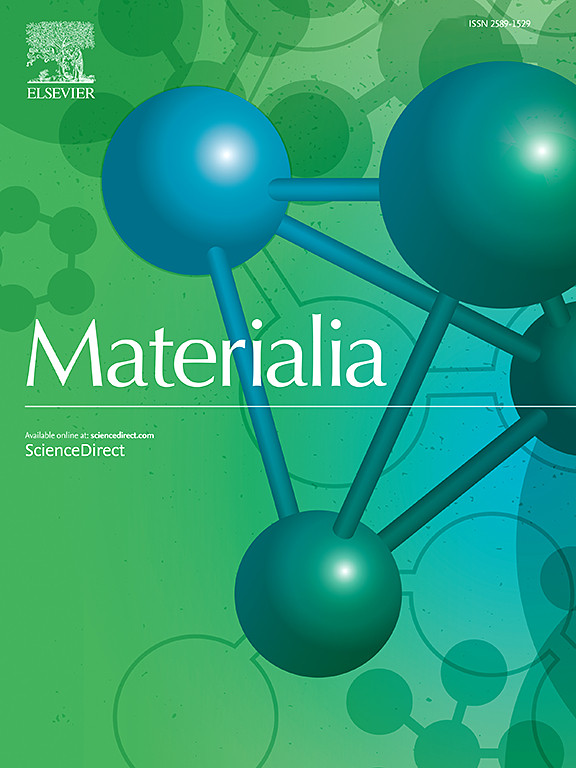纳米尺度的硅铝磷酸酯(SAPO)沸石:骨再生中骨诱导应用的结构调整
IF 2.9
Q2 MATERIALS SCIENCE, MULTIDISCIPLINARY
引用次数: 0
摘要
尽管传统骨修复生物陶瓷取得了重大进展,但开发具有固有骨诱导能力的材料仍然是一个挑战,突出了对积极促进成骨的创新生物材料的需求。在本研究中,采用水热合成纳米尺寸的磷酸铝(SAPO)沸石,对其结构进行了定制,并对其进行了表征,使其具有骨诱导性能。通过磷灰石矿化、降解、离子释放、蛋白质吸附、细胞粘附、活力和成骨前细胞的成骨分化来评估它们的体外生物活性。SAPO-34和SAPO-5晶体具有纳米片状形貌和亚纳米纳米孔拓扑结构,在保留晶体纳米孔结构的同时,将钙和锂离子结合到-内(CaSAPO, LiSAPO)和框架外(Ca/CaSAPO, Li/LiSAPO)位置。这些沸石在14天内促进了磷灰石的形成,这是由于它们的高表面积、优化的表面化学性质以及钙作为框架外阳离子的存在。在模拟的生理条件下,SAPO沸石表现出一定程度的降解(5-22 wt. %),并伴有Li +和Ca 2 +离子的持续释放。细胞相容性研究证实了成骨前细胞的生存能力和黏附力在14天内达到250µg/mL, Ca/CaSAPO和Li/LiSAPO形式显示出增强的生物相容性。纳米尺寸的SAPO颗粒在没有成骨补充剂的情况下刺激成骨细胞分化,不仅受生物活性离子释放的驱动,还受其固有的物理和化学特性的驱动,包括其纳米孔结构和表面组成。这些发现确定了SAPO沸石,特别是那些用锂和钙修饰的沸石,作为骨再生的有希望的候选者。未来的体内研究建议评估其与支架的整合以及在骨科和再生医学中的应用。本文章由计算机程序翻译,如有差异,请以英文原文为准。

Silicoaluminophosphate (SAPO) zeolites with nanometric dimensions: Structural tuning for osteoinductive applications in bone regeneration
Despite significant advancements in traditional bone repair bioceramics, developing materials with inherent osteoinductive capabilities remains a challenge, highlighting the need for innovative biomaterials that actively promote osteogenesis. In this study, aluminophosphate (SAPO) zeolites with nanometric dimensions were hydrothermally synthesized, structurally tailored, and characterized to develop osteoinductive properties. Their in vitro bioactivity was evaluated through assays of apatite mineralization, degradation, ion release, protein adsorption, cell adhesion, viability, and osteogenic differentiation using pre-osteoblast cells.
SAPO-34 and SAPO-5 crystals, engineered with nanosheet-like morphologies and sub-nanometer nanoporous topologies, incorporated calcium and lithium cations into intra- (CaSAPO, LiSAPO) and extraframework (Ca/CaSAPO, Li/LiSAPO) positions while preserving their crystalline nanoporous structure. These zeolites promoted apatite formation within 14 days, driven by their high surface area, optimized surface chemistry, and the presence of calcium as extraframework cations.
SAPO zeolites exhibited a degree of degradation (5–22 wt. %) under simulated physiological conditions, accompanied by the sustained release of Li⁺ and Ca²⁺ ions. Cytocompatibility studies confirmed pre-osteoblast viability and adhesion up to 250 µg/mL over 14 days, with Ca/CaSAPO and Li/LiSAPO forms showing enhanced biocompatibility. The nanosized SAPO particles stimulated osteogenic cell differentiation in the absence of osteogenic supplements, driven not only by the release of bioactive ions but also by their intrinsic physical and chemical characteristics, including their nanoporous structure and surface composition.
These findings identify SAPO zeolites, particularly those modified with lithium and calcium, as promising candidates for bone regeneration. Future in vivo studies are recommended to evaluate their integration into scaffolds and applications in orthopedic and regenerative medicine.
求助全文
通过发布文献求助,成功后即可免费获取论文全文。
去求助
来源期刊

Materialia
MATERIALS SCIENCE, MULTIDISCIPLINARY-
CiteScore
6.40
自引率
2.90%
发文量
345
审稿时长
36 days
期刊介绍:
Materialia is a multidisciplinary journal of materials science and engineering that publishes original peer-reviewed research articles. Articles in Materialia advance the understanding of the relationship between processing, structure, property, and function of materials.
Materialia publishes full-length research articles, review articles, and letters (short communications). In addition to receiving direct submissions, Materialia also accepts transfers from Acta Materialia, Inc. partner journals. Materialia offers authors the choice to publish on an open access model (with author fee), or on a subscription model (with no author fee).
 求助内容:
求助内容: 应助结果提醒方式:
应助结果提醒方式:


